Counting
Counting Squares
Q1) Count the number of triangles and squares in the given figure 1) 36 triangles, 7 squares 2) 38 triangles, 9 squares 3) 40 triangles, 7 squares 4) 42 triangles, 9 squares Solution: The figure may be labelled as shown. 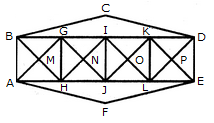 Triangles: The simplest triangles are BGM, GHM, HAM, ABM, GIN, UN, JHN, HGN, IKO, KLO, LJO, JIO, KDP, DEP, ELP, LKP, BCD and AFE i.e. 18 in number. The triangles composed of two components each are ABG, BGH, GHA, HAB, HGI, GIJ, IJH, JHG, JIK, IKL, KLJ, LJI, LKD, KDE, DEL and ELK i.e. 16 in number. The triangles composed of four components each are BHI, GJK, ILD, AGJ, HIL and JKE i.e. 6 in number. Total number of triangles in the figure = 18 + 16 + 6 = 40. Squares: The squares composed of two components each are MGNH, NIOJ and OKPL i.e. 3 in number. The squares composed of four components each are BGHA, GIJH, IKLJ and KDEL i.e. 4 in number. Total number of squares in the figure = 3 + 4 = 7. Q2) Count the number of triangles and squares in the given figure  1) 26 triangles, 5 squares 2) 28 triangles, 5 squares 3) 26 triangles, 6 squares 4) 28 triangles, 6 squares Solution: The figure may be labelled as shown. 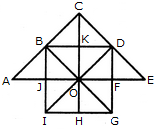 Triangles: The simplest triangles are JBO, BKO, KDO, DFO, FGO, GHO, HIO, IJO, ABJ, BCK, CKD and DEF i.e.12 in number. The triangles composed of two components each are IBO, BDO, DGO, GIO, ABO, CDO, CBO, CBD and DEO i.e. 9 in number. The triangles composed of four components each are IBD, BDG, DGI, GIB, ACO and COE i.e. 6 in number. There is only one. triangle i.e. ACE composed of eight components. Thus, there are 12 + 9 + 6 + 1 = 28 triangles in the given figure. Squares: The squares composed of two components each are BKOJ, KDFO, OFGH and JOHI i.e. 4 in number. There is only one square i.e. CDOB composed of four components. There is only one square i.e. BDGI composed of eight components. Thus, there are 4 + 1 + 1 = 6 squares in the given figure. Read More: Questions on Counting number of SquaresDownload: Practice Questions on Counting Geometrical FiguresQ3) Count the number of triangles and squares in the given figure  1) 28 triangles, 3 squares 2) 24 triangles, 5 squares 3) 28 triangles, 5 squares 4) 24 triangles, 3 squares Solution: The figure may be labelled as shown.  Triangles: The, simplest triangles are ABI, BGI, GHI, HAI, BCJ, CFJ, FGJ, GBJ, CDK, DEK, EFK and FCK i.e. 12 in number. The triangles composed of two components each are ABG, BGH, GHA, HAB, BCF, CFG, FGB, GBC, CDE, DEF, EFC and FGD i.e. 12 in number. The triangles composed of four components each are AGC, BFD, HBF and GCE i.e.4 in number. Thus, there are 12 + 12 + 4 = 28 triangles in the given figure. Squares: The squares composed of two components each are BJGI and CKFJ i.e. 2 in number. The squares composed of four components each are ABGH, BCFG and CDEF i.e. 3 in number. Total number of squares in the figure = 2 + 3 = 5. Q4) Count the number of triangles and squares in the given figure 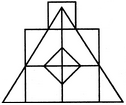 1) 21 triangles, 7 squares 2) 18 triangles, 8 squares 3) 20 triangles, 8 squares 4) 22 triangles, 7 squares Solution: The figure may be labelled as shown. 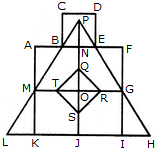 Triangles: The simplest triangles are BPN, PNE, ABM, EFG, MLK, GHI, QRO, RSO, STO and QTO i.e. 10 in number. The triangles composed of two components each are BPE, TQR, QRS, RST and STQ i.e. 5 in number. The triangles composed of three components each are MPO and GPO i.e. 2 in number. The triangles composed of six components each are LPJ, HPJ and MPG i.e. 3 in number. There is only one triangle LPH composed of twelve components. Total number of triangles in the figure = 10 + 5 - 2 + 3 + 1 = 21. Squares: The squares composed of two components each are KJOM and JIGQ i.e. 2 in number. The squares composed of three components each are ANOM, NFGO and CDEB i.e.3 in number. There is only one square i.e. QRST composed of four components. There is only one square i.e. AFIK composed of ten components. Total number of squares in the figure = 2 + 3 + 1 + 1 = 7. Read More: Questions on Counting number of RectanglesRead More: Shortcuts for Geometrical PatternsQ5) Count the number of triangles and squares in the given figure 1) 28 triangles, 10 squares 2) 28 triangles, 8 squares 3) 32 triangles, 10 squares 4) 32 triangles, 8 squares Solution: The figure may be labelled as shown. 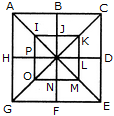 Triangles: The simplest triangles are IJQ, JKQ, KLQ, LMQ, MNQ, NOQ, OPQ and PIQ i.e. 8 in number. The triangles composed of two components each are ABQ, BCQ, CDQ, DEQ, EFQ, FGQ, GHQ, HAQ, IKQ, KMQ, MOQ and OIQ i.e. 12 in number. The triangles composed of four components each are ACQ, CEQ, EGQ, GAQ, IKM, KMO, MOI and OIK i.e. 8 in number. The triangles composed of eight components each are ACE, CEG, EGA and GAC i.e. 4 in number. Total number of triangles in the figure = 8 + 12 + 8 + 4 = 32. Squares: The squares composed of two components each are IJQP, JKLQ, QLMN and PQNO i.e. 4 in number. The squares composed of four components each are ABQH, BCDQ, QDEF and HQFG i.e. 4 in number. There is only one square i.e. IKMO composed of eight components. There is only one square i.e. ACEG composed of sixteen components. Thus, there are 4 + 4 + 1 + 1 = 10 squares in the given figure. Q6) Count the number of triangles and squares in the given figure  1) 44 triangles, 10 squares 2) 14 triangles, 16 squares 3) 27 triangles, 6 squares 4) 36 triangles, 9 squares Solution: The figure may be labelled as shown. 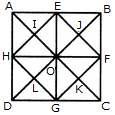 Triangles: The simplest triangles are AEI, EOI, OHI, HAI, EBJ, BFJ, FOJ, OEJ, HOL, OGL, GDL, DHL, OFK, FCK, CGK and GOK i.e. 16 in number. The triangles composed of two components each are HAE, AEO, EOH, OHA, OEB, EBF, BFO, FOE, DHO, HOG, OGD, GDH, GOF, OFC, FCG and CGO i.e. 16 in number. The triangles composed of four components each are HEF, EFG, FGH, GHE, ABO, BGO, CDO and DAO i.e. 8 in number. The triangles composed of eight components each are DAB, ABC, BCD and CDA i.e. 4 in number. Total number of triangles in the figure = 16 + 16 + 8 + 4 = 44. Squares: The squares composed of two components are HIOL, IEJO, JFKO and KGLO i.e. 4 in number. The squares composed of four components are AEOH, EBFO, OFGC and HOGD i.e.4 in number. There is only one square EFGH which is composed of eight components. There is only one square ABCD which is composed of sixteen components. Total number of squares in the figure = 4 + 4 + 1 + 1 = 10. Read More: Questions on Counting number of Parallelograms |